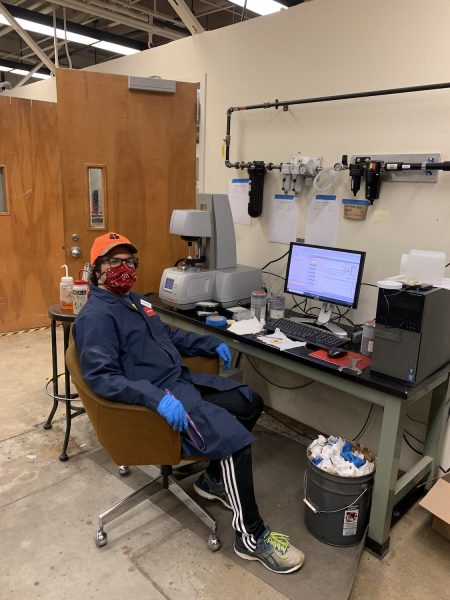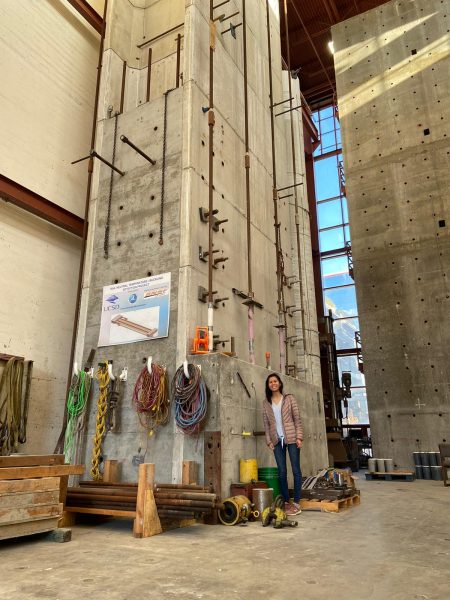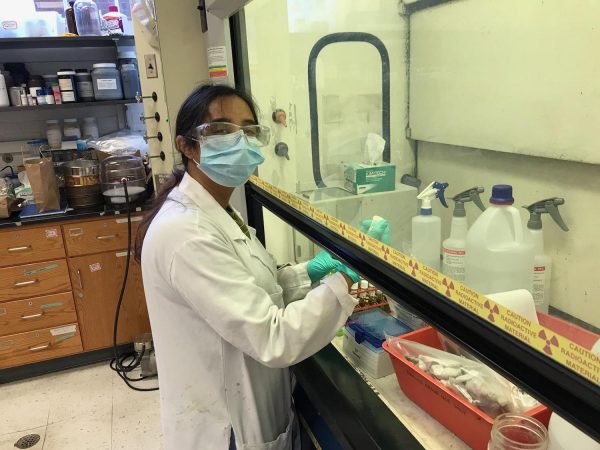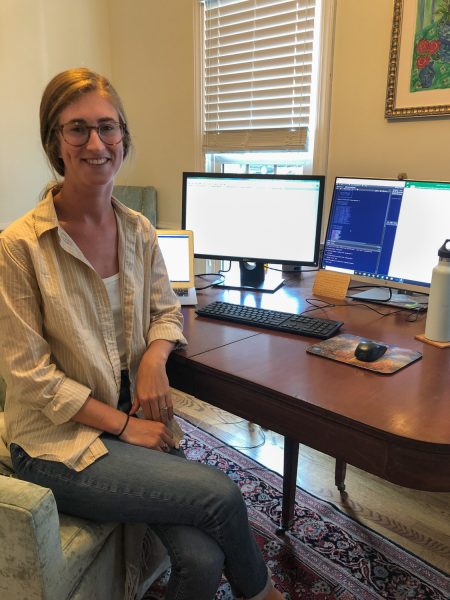What happens when, with very little warning, a research laboratory has to be closed? In our CCEE department, we have more than a dozen laboratories in Mann Hall, Broughton Hall, Burlington Hall and the Constructed Facilities Lab (CFL) on Centennial campus. About 175 Master’s and Ph.D. students carry out research, as well as work as research assistants on numerous projects led by our faculty. There are currently more than 200 active research projects in our department, which total more than 16 million dollars in public and private funding.
In early March, Komal Charania was finishing months of preparing for an experiment that would allow her to collect data about the rate of cotton biodegradation in landfills. The protocol had been approved, she had carefully grown a population of microorganisms that would simulate a landfill, prepared her samples, and was preparing to set up mini bioreactors in the Environmental Lab during Spring Break, the week of March 8th. Charania was also monitoring another experiment, in which she was measuring the effect of temperature on cellulose hydrolysis in landfills. She was on track to complete her Master’s of Science in Environmental Engineering by the end of 2020.
Things changed quickly for Charania, and many other Master’s and Ph.D. students, as well as faculty, when the University announced in mid March that campus and the laboratories were closing due to the global health emergency caused by COVID-19.
In dozens of our laboratories, experimental work was halted with little warning. The impacts include lost time, delayed findings, and in some cases lost funding.
“The Constructed Facilities Laboratory (CFL) has been significantly impacted by COVID19, and those impacts persist. Nearly all our research relies heavily on experimental work. While the laboratories were closed, much of this work necessarily came to a standstill. Where possible, researchers continued to process data, design experiments, and work on publications — however, the inability to collect experimental data dramatically slowed progress on many research programs and industrial testing projects.” Dr. Greg Lucier, Research Associate Professor and CFL Lab Manager
RE-OPENING SLOWLY AND CAUTIOSLY
The laboratories were closed from mid-March until May 29th, and re-opening is happening slowly with many precautions in place. Andrew Fried is a 2nd-year Ph.D. candidate and works in one of the transportation materials labs in Mann Hall. Like Charania, Fried was at a critical juncture on his research. “I study asphalt binders with the goal of extending the life of pavement made from recycled asphalt material,” Fried explains. “Binder is the black material you see in asphalt – it’s like the glue that holds pavement together. We work with many manufacturers who provide us with their binder, then I create different blends with rejunvenators and recycled asphalt binders.” Just before the laboratories were closed, Fried had his work flow finalized, was finishing up some tests on the equipment, and was collecting samples. “I had to stop everything, go home, and could only work on my literature review,” Fried explains.

As the labs reopen, each lab has specific guidelines for operating safely based on the square footage, equipment needs, and other considerations. In the materials lab where Fried works, no more than two students can be in the space at the same time, and there has to be 30 minutes between each shift. “We wear masks, stay physically distanced, and of course wipe down every surface we’ve touched”, Fried said. Individual students are allowed no more than 20 hours per week in the lab.
Dr. Cassie Castorena, who mentors Fried and several other students who use the Asphalt Materials Labs, says that even though Fried lost some time gathering data, he was able to use his time productively. “Andrew completed his literature review, and drafted a review paper that we intend to submit for peer review publication. His experiments will be better informed now that we have been allowed to return to the lab, and I don’t think it will affect his graduation date,” Castorena said.
Dr. Mohammad Pour-Ghaz leads the Sensing and Materials Research Team (SMART) Lab. It is a small space, so with physical distancing, only one researcher at a time is permitted, and there is a minimum of one hour between the 4-hour shifts. He echoes Castorena’s thoughts regarding impact on students. “One of the Ph.D. students, Laura Dalton, who works in my lab had just collected a lot of data before the labs closed. I think because she had more time at her desk, this might have even increased her productivity.” Dalton was able to complete a paper, has submitted it, and had it accepted by the scientific journal Transport in Porous Media. Another student, Payum Hosseini, was in the midst of experiments including field and laboratory work. His focus is quantifying ingress of volatile organic compounds into concrete that come in contact with concrete pipes buried in soil. Hosseini creates samples in the form of capsules, which he buries for various lengths of time and then brings back to the lab for data collection. “In his case, the time he lost is not one to one. It is likely that his graduation could be delayed as much as two semesters,” Pour Ghaz relayed. “You can’t just pause an experiment and start back. Samples have to be remade, and cured.”
Dr. Jason Patrick, who leads the Multifunctional Composites Group, also indicated that samples fabricated prior to closure were no longer reliable after sitting for several months. “The materials we were working with have embedded, pre-tensioned fibers which unfortunately suffered stress relaxation over the time that we were closed. This resulted in different mechanical properties, so we will have to refabricate them. The loss in experimental continuity has made it difficult to recoup the research momentum we had nearly three months ago.”
BEYOND DATA. THE EMOTIONAL TOLL.
Apart from the measurable and concrete effects of the lab shut downs, there is an emotional toll that many graduate students have expressed as well.

“I was trying to keep a positive perspective on the whole situation and try to use the time to my advantage, but it was really tough. I felt sad about not being able to go to the lab. Getting a Ph.D. is a daunting task, and I think not being able to have the balance of interacting and socializing with people going through the same experiences has been the hardest part. It was also disappointing that many of the opportunities that we’ve worked hard towards were canceled or indefinitely delayed.”
Jessi Thangjitham, Ph.D. Candidate
Jessi Thangjitham is a Ph.D. candidate who was preparing to run large scale experiments on bridge columns to collect data regarding their performance under earthquake ground motions. Luckily in her case, she already had several sets of data, and was able to concentrate on the computational work associated with the existing data. “I was able to adapt to the abrupt change in my scheduled lab tests, and focus on the computational components of my research which I could complete from home,” Thangjitham said.
LOOKING OUT FOR EACH OTHER
Resilience and the willingness to adapt is the theme repeated throughout the labs.

“I feel quite frustrated, but I understand that the university is taking precautions to keep me safe in the lab. Our lab manager has done a lot of work to keep us safe and has been extremely helpful. I do miss seeing all of the other students in the lab and it was sad not to get to say goodbye to those graduating. However, everyone is doing the best they can, and I don’t want to push for a reopening that would cause the virus to spread. This department has some amazing professors doing important work and we need to keep everyone safe.” Komal Charania, M.S. Student
Dr. Lisa Castellano is the manager of the environmental lab where Charania and many other researchers are cautiously returning. She has worked with technicians to recalibrate lab equipment that sat idle. Like all lab managers, she is also working closely with Facilities to insure proper air flow, set up lab traffic patterns, designate dedicated entrances and exits, and develop policies to keep students safe in work areas. Castellano provides perspective, and reminds us all that we’re all in this together.
“Working in the laboratory is a collaborative effort often requiring one-on-one discussions. Physical distancing has forced us to re-evaluate how we communicate and work with each other. Distancing measures within laboratory spaces, enhanced PPE including masks, and telecommunication are now the new normal. These measures serve to protect us but also force us to be more creative in our interactions. These new forms of communication and work force us not only to be more thoughtful in our interactions but provide an opportunity for all of us to be more cognizant of each other’s well-being.” Lisa Castellano, Lab Manager
PERSPECTIVE, MAKING THE BEST OF IT

Nancy Lee Alexander is a second year Ph.D. candidate in the research group of Dr. Detlef Knappe. She is developing new methods to study emerging contaminants in drinking water. “I had been working closely with community members and home owners sampling private wells across North Carolina,” Alexander said. “I’m very lucky actually, because I already had lots of data, so I took this opportunity to catch up on data analysis. It’s been helpful to have some time in front of the computer, and I’ve been able to work toward providing results to individuals who are part of our study.”
“While lab closures were disruptive, the department is cognizant that relative to other potential outcomes such as job and income loss, our challenges were manageable. Most of our graduate students found ways to use the time during which they could not work in the lab to their advantage. We are getting back into the lab just in time. Ultimately, for many of our faculty and students, it is the data that we generate in the lab that is needed to prove hypotheses that expand our knowledge of the natural and built environments.” CCEE Department Head Dr. Morton Barlaz

